
The Motorola Razr is a brand of design-oriented mobile phones manufactured by Motorola Mobility, a division of Lenovo. Its current iteration since 2019, styled motorola razr, consist of foldable smartphones reminiscent of the original Razr line of flip phones.

Motorola Mobility LLC, marketed as Motorola, is an American consumer electronics manufacturer primarily producing smartphones and other mobile devices running Android. Headquartered at Merchandise Mart in Chicago, Illinois, it is a subsidiary of the Chinese multinational technology company Lenovo.
Motoblur is a discontinued Android user interface and push-based service focused on social networking, developed by Motorola.
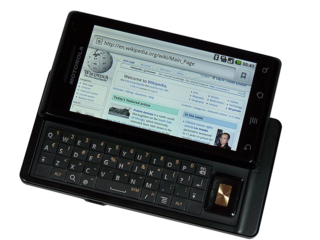
The Motorola Droid is an Internet and multimedia-enabled smartphone designed by Motorola, which runs Google's Android operating system. The Droid had been publicized under the codenames Sholes and Tao and the model number A855. In Latin America and Europe, the model number is A853 (Milestone), and in Mexico, the model number is A854 (Motoroi). Due to the ambiguity with newer phones with similar names, it is also commonly known as the DROID 1. The brand name Droid is a trademark of Lucasfilm licensed to Verizon Wireless.

The Droid X is a smartphone released by Motorola on July 2010. The smartphone was renamed Motoroi X for its release in Mexico on November 9, 2013. The Droid X runs on the Android operating system, and the latest version supported was 2.3 Gingerbread. It was distributed by Verizon Wireless in the United States and Iusacell in Mexico.
Rooting is the process by which users of Android devices can attain privileged control over various subsystems of the device, usually smartphones. Because Android is based on a modified version of the Linux kernel, rooting an Android device gives similar access to administrative (superuser) permissions as on Linux or any other Unix-like operating system such as FreeBSD or macOS.
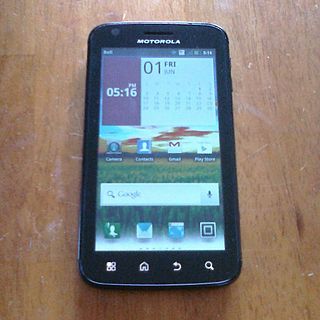
The Motorola Atrix 4G is an Android-based smartphone developed by Motorola, introduced at CES 2011 along with the Motorola Xoom, Motorola Droid Bionic, and Motorola Cliq 2 on January 5, 2011. It was made available in the first quarter of 2011.

The Motorola Droid Bionic is an Android-based, 4G LTE-capable smartphone designed by Motorola. It was originally scheduled for release in Q2 2011 but was delayed, eventually being released on 8 September 2011.

The Motorola DROID 3 is a smartphone released on July 7, 2011, by Verizon Wireless running the Android 2.3 operating system by Google. It comes with 16 GB of internal storage. The smartphone does not ship with a microSD card. It has a 4-inch qHD display and an 8-megapixel camera capable of recording 1080p video. Unlike the DROID 2, the Motorola DROID 3 features a 5-row QWERTY keyboard, with a dedicated number row. It also has a VGA front-facing camera for video calls. The Droid 3 ships with Android 2.3.4 (Gingerbread) with Motorola's updated proprietary Motoblur UI. Like other contemporary Motorola phones, it has a locked bootloader, but it can have a custom rom using SafeStrap.
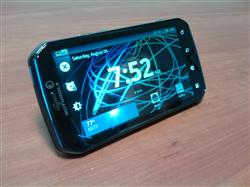
The Motorola Photon 4G was a high end Android-based mobile smartphone that was distributed exclusively by Sprint. A very similar model was available as the Motorola Electrify from U.S. Cellular.
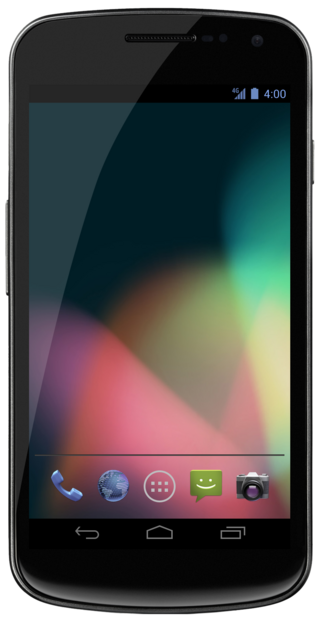
The Galaxy Nexus (GT-I9250) is a touchscreen Android smartphone co-developed by Google and Samsung Electronics. It is the third smartphone in the Google Nexus series, a family of Android consumer devices built by an original equipment manufacturer partner. The phone is the successor to Google's previous flagship phones, the Nexus One and Nexus S.

The Motorola Droid 4 (XT894) is a smartphone made by Motorola Mobility. It was released with Android 2.3 and can be upgraded to Android 4.1. It was released on Verizon Wireless's network on February 10, 2012. It is the successor to Motorola's Droid 3, and is one of the first smartphones to support GLONASS in addition to GPS.
The Motorola Photon Q 4G LTE (XT897) is a smartphone manufactured by Motorola which runs on Sprint's 4G LTE network. The "Photon Q" has a 4.3-inch touchscreen and a 1.5 GHz dual-core processor. It runs the Android operating system and includes a built-in, sliding keyboard similar to the one on the Motorola Droid 4.

The Droid Razr M is an Android-based, 4G LTE-capable smartphone designed by Motorola as a smaller successor to the Droid Razr. It was advertised as "The full screen phone" with thin edges, though it lacked a robust resolution. It came with a light skin of Android for Verizon Wireless (XT907), SoftBank Mobile (XT902), and Telstra as well as an unbranded retail version for the Australian market. The Electrify M (XT901) for U.S. Cellular is a CDMA handheld with a different housing, but otherwise same specification as the Razr M.

The Droid Razr HD and Droid Razr Maxx HD are Android-based, 4G LTE-capable smartphones designed by Motorola as the successor to the Droid Razr series released nearly a year prior. Notable changes from their predecessors include 720p resolution displays and increased display size while maintaining similar overall dimensions. Additionally, the battery capacity on the standard Razr HD is 42% larger than its predecessor. Both go by the model number XT926. These phones were released on October 18, 2012 exclusively on Verizon Wireless in the United States. The Motorola Razr HD were available as international or global phones in Europe, Latin America, Australia and Canada as early as October 2, 2012. In the summer of 2013, storyboards surfaced of television commercials that have not yet aired. These commercials will feature the Droid Maxx and Droid Ultra, the apparent successors to the Droid Razr Maxx HD and Droid Razr HD, respectively.

Moto X is an Android smartphone developed and manufactured by Motorola Mobility, and released in August 2013.
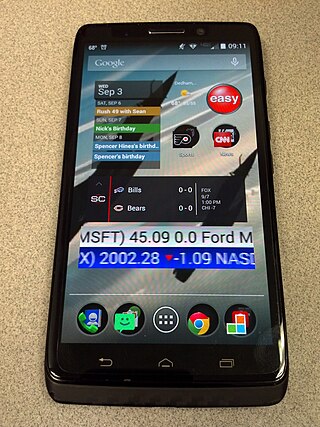
The Droid Maxx is a smartphone developed by Motorola Mobility. It is the first Droid to be a high end smartphone exclusively developed by Motorola for Verizon Wireless. It is part of the Verizon Droid line, and was announced on 23 July 2013 along with the Droid Ultra and Droid Mini at a joint Motorola and Verizon Wireless press conference.

The Droid Turbo is a high end smartphone developed by Motorola Mobility. It is part of the Verizon Droid line, and was announced on October 28, 2014 on the Verizon Droid Does website. The Droid Turbo maintains a similar design shape to its predecessor, the Droid Maxx, with new durable ballistic nylon or metallized glass fiber reinforced with Kevlar as the materials offered. The on-screen buttons for back, home, and multitask functions were kept off-screen as capacitive soft-keys below the display. Due to Lenovo closing its acquisition of Motorola Mobility from Google, the Droid Turbo was the first phone released by Motorola Mobility under Lenovo ownership, as it was released through Verizon Wireless first on the same day the Lenovo sale closed, October 30, 2014.

Iqbal Arshad is an American engineer, inventor, speaker and technology executive. He has served as the senior vice president of engineering and global product development at Motorola Mobility, Google and Lenovo, and has been responsible for design and development of industry-leading smartphones, tablets smartwatches, wearables, silicon, and mobile computing technologies.

Bootloader unlocking is the process of disabling the bootloader security that makes secure boot possible. It can make advanced customizations possible, such as installing a custom firmware. On smartphones this can be a custom Android distribution or another mobile operating system. Some bootloaders are not locked at all, others can be unlocked using a standard command, others need assistance from the manufacturer. Some do not include an unlocking method and can only be unlocked through a software exploit.



















